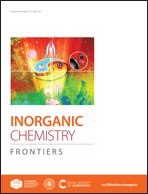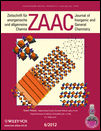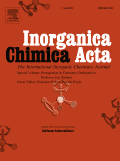
Inorganic Chemistry Frontiers
Scope & Guideline
Fostering Global Insights in Inorganic Chemistry
Introduction
Aims and Scopes
- Inorganic Synthesis and Characterization:
The journal emphasizes the development of novel inorganic compounds, including metal-organic frameworks (MOFs), coordination complexes, and nanostructures, using various synthetic methodologies. - Catalysis and Electrocatalysis:
A significant focus is on the application of inorganic materials in catalytic processes, particularly for energy conversion and environmental remediation, with a strong emphasis on electrocatalysis for hydrogen evolution and CO2 reduction. - Materials for Energy Storage and Conversion:
Research on materials for batteries, supercapacitors, and fuel cells is prevalent, particularly advancements in lithium, sodium, and zinc-ion batteries, as well as the development of new materials for solar energy applications. - Nanotechnology and Nanomaterials:
The journal publishes studies on the synthesis and application of nanoscale materials, exploring their unique properties and potential applications in catalysis, sensing, and drug delivery. - Environmental and Biological Applications:
There is a growing interest in the application of inorganic materials in environmental science, including water purification, pollutant degradation, and biomedical applications, particularly in drug delivery and imaging.
Trending and Emerging
- Sustainable and Green Chemistry:
Research increasingly emphasizes sustainable practices and the development of green catalysts and processes, particularly in the context of CO2 reduction and hydrogen production. - Advanced Energy Materials:
There is a strong trend towards developing new materials for energy applications, including high-performance batteries, supercapacitors, and fuel cells, focusing on efficiency and stability. - Photocatalysis and Photoelectrochemistry:
The application of inorganic materials in photocatalytic processes has surged, with a focus on solar energy conversion and pollutant degradation, revealing a significant interest in sustainable energy solutions. - Single-Atom Catalysis:
Research on single-atom catalysts is gaining prominence, showcasing their potential for enhanced catalytic performance through precise control of active sites. - Nanostructured Materials for Biomedical Applications:
The use of nanostructured inorganic materials in biomedical applications, including drug delivery and imaging, is on the rise, reflecting an intersection of materials science and health sciences.
Declining or Waning
- Traditional Coordination Chemistry:
Research focused solely on classical coordination compounds with limited application scope has seen a decline, as more emphasis is placed on multifunctional and application-oriented materials. - Low-dimensional Magnetic Materials:
Interest in low-dimensional magnetic materials appears to be waning, possibly due to the growing focus on more complex materials with enhanced functionalities and applications. - Inorganic Materials for Optical Applications:
Although still relevant, the specific study of inorganic materials for traditional optical applications has seen reduced emphasis in favor of materials with multifunctional properties, such as photonic and electronic applications. - Thermal Catalysis:
Research dedicated solely to thermal catalysis, particularly in conventional catalytic systems, has decreased as more innovative approaches, such as photocatalysis and electrocatalysis, gain traction. - Basic Inorganic Chemistry:
The exploration of fundamental inorganic chemistry concepts, while still important, has seen a relative decline as the field shifts towards more applied and interdisciplinary studies.
Similar Journals

Science China-Chemistry
Unveiling Breakthroughs in Chemical ResearchScience China-Chemistry, published by SCIENCE PRESS, stands as a leading journal in the field of chemistry, specifically recognized for its contributions in miscellaneous chemistry domains. With an impressive Q1 categorization in the 2023 quartiles and ranking at #35/408 in general chemistry by Scopus, this journal places itself within the top 91st percentile, showcasing its significant impact in the discipline. The journal, based in Beijing, China, provides a platform for innovative research, reviews, and insights that cater to an international audience of researchers, professionals, and students dedicated to advancing chemical science. As an open-access journal, it ensures widespread dissemination of knowledge, making cutting-edge research accessible to all. With converged years from 2010 to 2024, the journal continues to be a vital resource for those engaged with the latest developments in chemistry.

NEW CARBON MATERIALS
Pioneering Research in Carbon NanomaterialsNEW CARBON MATERIALS, published by Elsevier, is a leading academic journal that focuses on the innovative and multidisciplinary field of carbon materials research. With an ISSN of 2097-1605 and an E-ISSN of 1872-5805, this journal has established itself as a prominent platform for disseminating cutting-edge studies and applications in the realm of carbon nanomaterials, composites, and their industrial applications. Recognized for its high quality, NEW CARBON MATERIALS holds a Q1 ranking in the Materials Science category, reflecting its significant impact within the scientific community. The journal has continuously fostered knowledge exchange since its inception in 2004 and is set to further advance research until 2024. With a Scopus rank of #89 out of 463 journals in the General Materials Science category, this publication is essential for researchers, professionals, and students seeking to stay informed about the latest developments in carbon materials. While it is not an open-access journal, it offers various access options to ensure that the latest findings are available to a broad audience. By bridging the gap between theory and practical application, NEW CARBON MATERIALS is at the forefront of addressing critical challenges and paving the way for future advancements in materials science.

REVIEWS IN INORGANIC CHEMISTRY
Empowering Researchers with Invaluable InsightsREVIEWS IN INORGANIC CHEMISTRY, published by Walter de Gruyter GmbH, is a distinguished academic journal that serves as a vital resource for researchers, professionals, and students within the field of inorganic chemistry. With its ISSN 0193-4929 and E-ISSN 2191-0227, this journal has made a significant impact on the discipline, holding a commendable Q2 ranking in the 2023 category of Inorganic Chemistry, placing it in the 81st percentile among its peers according to Scopus rankings. Continuously published since its inception, with converged years spanning from 1985 to 1990 and 1992 to 2024, it features comprehensive reviews encompassing the latest advancements, methodologies, and theoretical frameworks in the subject. Researchers will find IDEAL insights and valuable discussions that keep them abreast of trends and challenges in the domain, essential for driving innovation and collaboration. The journal’s commitment to quality and rigorous peer review highlights its importance in advancing inorganic chemistry research, making it an indispensable tool for academic excellence.

Small Science
Catalyzing Knowledge in Materials and EngineeringSmall Science is an esteemed open-access journal published by WILEY, dedicated to pioneering research in the realms of catalysis, materials science, and chemical engineering. Established in 2021, this journal has rapidly gained recognition, ranking in the top quartiles (Q1) in various categories, including a remarkable 17th position in Materials Science and 8th in Chemical Engineering on Scopus. With an impact factor reflective of its growing influence and a commitment to disseminating cutting-edge knowledge, Small Science serves as a crucial platform for researchers, professionals, and students seeking to explore the latest advancements and applications in these dynamic fields. The journal's open-access model ensures wide reach and accessibility, facilitating collaboration and innovation across disciplines. Its headquarters are located in the United States, at 111 River St, Hoboken, NJ, supporting a global readership keen on addressing contemporary scientific challenges and driving progress in technology and materials synthesis.

ZEITSCHRIFT FUR ANORGANISCHE UND ALLGEMEINE CHEMIE
Innovating the Future of Chemical SciencesZEITSCHRIFT FUR ANORGANISCHE UND ALLGEMEINE CHEMIE, published by WILEY-V C H VERLAG GMBH, is a pivotal journal in the field of inorganic chemistry, catering to the needs of researchers, professionals, and students seeking to advance their understanding of this dynamic discipline. With its historical roots dating back to 1892 and a commitment to high-quality research, this journal provides a platform for the dissemination of significant findings related to inorganic substances and their general chemistry. Although currently not an open-access journal, it holds a competitive position with an impact factor placing it in the Q3 quartile of the Inorganic Chemistry category, ranking #57 out of 79 in Scopus. Situated in Germany, this journal not only connects past and present research endeavors but also aims to foster innovation and collaboration within the inorganic chemistry community. Whether you are exploring fundamental concepts or groundbreaking applications, ZEITSCHRIFT FUR ANORGANISCHE UND ALLGEMEINE CHEMIE remains an invaluable resource for advancing chemical sciences.

Journal of Inorganic and Organometallic Polymers and Materials
Transforming Research into Revolutionary MaterialsThe Journal of Inorganic and Organometallic Polymers and Materials, published by SPRINGER, is a premier academic journal dedicated to advancing the field of materials science, particularly in the domains of inorganic and organometallic polymers. Established in 1996, this journal has successfully converged multiple years of research, reflecting the dynamic evolution of the field through to 2024. With an impressive Scopus Rank placing it in the top 81st percentile in both Materials Chemistry and Polymers and Plastics, it is recognized for its significant contributions and innovations. The journal is classified in the prestigious Q2 Category, indicating its influence and relevance among leading publications. While it operates under a subscription model, the journal is committed to disseminating cutting-edge research, providing insights that empower researchers, professionals, and students to push the boundaries of materials chemistry and polymer science. Its focus on high-quality, peer-reviewed articles ensures that readers are equipped with the latest findings and methodologies that drive this exciting and rapidly evolving field.

INORGANICA CHIMICA ACTA
Driving Excellence in Inorganic ResearchINORGANICA CHIMICA ACTA is a distinguished journal published by Elsevier Science SA, focusing on the dynamic fields of inorganic chemistry, materials chemistry, and physical and theoretical chemistry. Established in 1967, the journal continues to contribute to the scientific community with a commitment to high-quality research and innovation, boasting a 2023 Scopus ranking that places it at the forefront of its category, including a notable rank of #25 out of 79 in Inorganic Chemistry. Researchers can access a wealth of knowledge through its assemblage of influential articles; though it does not offer open access, the journal remains a key resource in the Netherlands and beyond. With an impact factor reflective of its rigorous editorial standards and engagement, INORGANICA CHIMICA ACTA is essential for scholars and professionals seeking to deepen their understanding and advance their research in these interconnected scientific domains.

SusMat
Empowering Change through Sustainable Material ScienceSusMat is a pioneering open access journal published by WILEY, with an ISSN of 2766-8479 and E-ISSN of 2692-4552, dedicated to advancing knowledge in the field of sustainable materials and technologies. Launched in 2021, SusMat aims to provide a vibrant platform for researchers, professionals, and students from interdisciplinary backgrounds to explore and disseminate innovative materials and strategies that promote sustainability. With an emphasis on high-quality, peer-reviewed research, this journal contributes to the growing body of literature essential for addressing contemporary environmental challenges. Furthermore, the open access format enhances accessibility and dissemination of knowledge, encouraging broader engagement and collaboration within the scientific community. Discover the future of sustainable materials at SusMat, where impactful research meets global sustainability goals.

EUROPEAN JOURNAL OF INORGANIC CHEMISTRY
Fueling Collaboration and Innovation in Inorganic ChemistryThe EUROPEAN JOURNAL OF INORGANIC CHEMISTRY, published by WILEY-V C H VERLAG GMBH, is a premier peer-reviewed journal dedicated to advancing the field of inorganic chemistry. With an ISSN of 1434-1948 and an E-ISSN of 1099-0682, this journal has established itself as a key platform for the dissemination of innovative research, reviews, and features since its inception. As of 2023, it holds a respectable Q2 quartile ranking in the domain of inorganic chemistry, reflecting its influence and contribution to the scientific community—ranking #33 out of 79 in Scopus’ assessment and placing the journal in the 58th percentile. The journal encompasses a wide range of topics within inorganic chemistry, making it a valuable resource for researchers, professionals, and students alike. Although the journal does not currently offer open access, it remains an essential outlet for high-quality, impactful studies in inorganic chemistry, showcasing significant advancements and fostering collaboration among scholars globally.

Nano Energy
Innovating Tomorrow's Energy SolutionsNano Energy is a premier journal published by Elsevier, focused on the dynamic intersection of nano-technology and energy solutions. Since its inception in 2012, this high-impact journal has made significant strides in advancing research across multiple disciplines, showcasing groundbreaking studies in Electrical and Electronic Engineering, Materials Science, and Renewable Energy. With an impressive Impact Factor that places it in the Q1 category of these fields—including a distinguished rank of #6 in Electrical Engineering and #9 in Renewable Energy on Scopus—the journal serves as a vital resource for academics and practitioners alike. Nano Energy aims to disseminate innovative research and developments that contribute to the sustainable energy landscape, thereby addressing pressing global energy challenges. Researchers and professionals seeking to stay at the forefront of nanotechnology applications in energy generation and efficiency will find this journal an indispensable platform for sharing knowledge and driving impact.